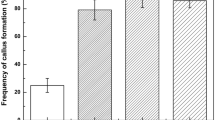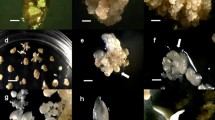Summary
Different ecotypes of reed (Phragmites communis Trinius) provide an ideal resource for studies on plant environmental adaptations and presence of genes relating to stress resistance. Dune reed is a drought-tolerant reed ecotype growing in the desert regions of north-west China. In this work, in vitro culture systems of dune reed and local swamp reed (as control) were established by optimizing the culture conditions for each of them. Bright yellow calluses were induced on a Murashige and Skoog medium containing 4.5 μM 2,4-dichlorophenoxyacetic acid (2,4-D), 5.4 μM naphthaleneacetic acid and 2.2μM benzyladenine. Benzyladenine promoted callus induction, but was not required for callus maintenance. Four types of callus have been identified from each of the reed ecotypes. Two types of callus, i.e. type A (formed normal green shoots) and type C (formed albino plants), were both found as embryogenic calluses. The optimal concentrations of 2,4-D to maintain embryogenic callus were 2.3–4.5 μM for dune reed and 9.0–13.5 μM for swap reed. Plant regeneration was achieved from types A and C callus in a hormone-free medium. The embryogenic calluses of swamp reed have been maintained for over 2 yr and still retain their strong embryogenic potential; however, those of dune reed gradually lost their embryogenic potential after only 7 mo. of culture. Regenerated plants from the two reed ecotypes showed, after a growth season, similar morphology and the same chromosome number (2n=8x=96, octoploid) as the wild plants.
Similar content being viewed by others
References
Bregitzer, P. Plant regeneration and callus type in barley: effects of genotype and culture medium. Crop Sci. 32:1108–1112; 1992.
Cheng, Y. F.; Pu, T. L.; Xue, Y. B.; Zhang, C. L. PcTGD, a highly expressed gene in stem, is related to water stress in reed (Phragmites communis Trin.). Chinese Sci. Bull. 46:850–854; 2001.
Hronec, O.; Hajduk, J. Remarkable resistance of Phragmites australis (Cav.) Trin. growing on soils intoxicated by magnesium immissions. Ekologia Bratislava 17(2):117–124; 1998.
Lauzer, D.; Dallaire, S.; Vincent, G. In vitro propagation of reed grass by somatic embryogenesis. Plant Cell Tiss. Organ Cult. 60:229–234; 2000.
Murashige, T.; Skoog, F. A revised medium for rapid growth and bioassays with tobacco tissue cultures. Physiol. Plant. 15:473–497; 1962.
Pu, T. L.; Cheng, Y. F.; Zhang, C. L. Novel small compound specified in dune reed (Phragmites communis Trin.) and its possible role as a protectant on the chloroplasts under stress. Chinese Sci. Bull. 45:2062–2067; 2000.
Ren, D. T.; Zhang, C. L. Analyses of soluble protein, total and free amino acids in leaves of different ecotypes of Phragmites communis growing in the Hexi corridor. Acta Bot. Sinica 34:698–704; 1992.
Sangwan, R. S.; Gorenfolt, R. In vitro culture of Phragmites tissues. Callus formation, organ differentiation and cell suspension culture. Z. Pflanzenphysiol. 75:256–269; 1975.
Sokal, R. R.; Rohlf, F. J. Biometry: The principles and practice of statistics in biological research, 3rd edn. New York: Freeman and Co.; 1995.
Straub, P. F.; Decker, D. M.; Gallagher, J. L. Tissue culture and long-term regeneration of Phragmites australis (Cav.) Trin. ex Steud. Plant Cell Tiss. Organ Cult. 15:73–78; 1988.
Van der Toorn, J. Variability of Phragmites australis (Cav.) Trin. ex. Steudel in relation to the environment. Van zee tot land 48:122–127; 1972.
Van der Werff, M. Common reed. In: Rozema, J.; Verkleij, J. A. C., eds. Ecological responses to environmental stresses. Dordrecht: Kluwer Academic Publishers; 1991:172–182.
Vasil, I. K. Developing cell and tissue culture systems for the improvement of cereal and grass crops (Review). J. Plant Physiol. 128:193–218; 1987.
Waisel, Y.; Rechaw, Y. Ecotypic differentiation in Phragmites communis Trin. Hydrobiologia 12:259–266; 1971.
Wang, H. L.; Zhang, C. L. Seasonal changes of endogenous ABA and cytokinins in environmental adaptation of different ecotypes of reed plants. J. Environ. Sci. 7:449–454; 1995.
Wang, H. L.; Zhang, C. L.; Liang, H. G. Seasonal changes of polyamines in habitat adaptation of different ecotypes of reed plants. Oecologia 101:119–123; 1995.
Zheng, W. J.; Zheng, X. P.; Zhang, C. L. A survey of photosynthetic carbon metabolism in 4 ecotypes of Phragmites communis in northwest China: leaf anatomy, ultrastructure, and activities of ribulose 1,5-bisphosphate carboxylase, phosphoenolpyruvate carboxylase and glycollate oxidase. Physiol. Plant. 110:201–208; 2000.
Ziauddin, A.; Kasha, K. J. Long-term callus cultures of diploid barley (Hordeum vulgare): II. Effect of auxins on chromosomal status of cultures and regeneration of plants. Euphytica 48:171–176; 1990.
Author information
Authors and Affiliations
Corresponding author
Rights and permissions
About this article
Cite this article
Cui, S., Wang, W. & Zhang, C. Plant regeneration from callus cultures in two ecotypes of reed (Phragmites communis Trinius). In Vitro Cell.Dev.Biol.-Plant 38, 325–329 (2002). https://doi.org/10.1079/IVP2002296
Received:
Accepted:
Issue Date:
DOI: https://doi.org/10.1079/IVP2002296




